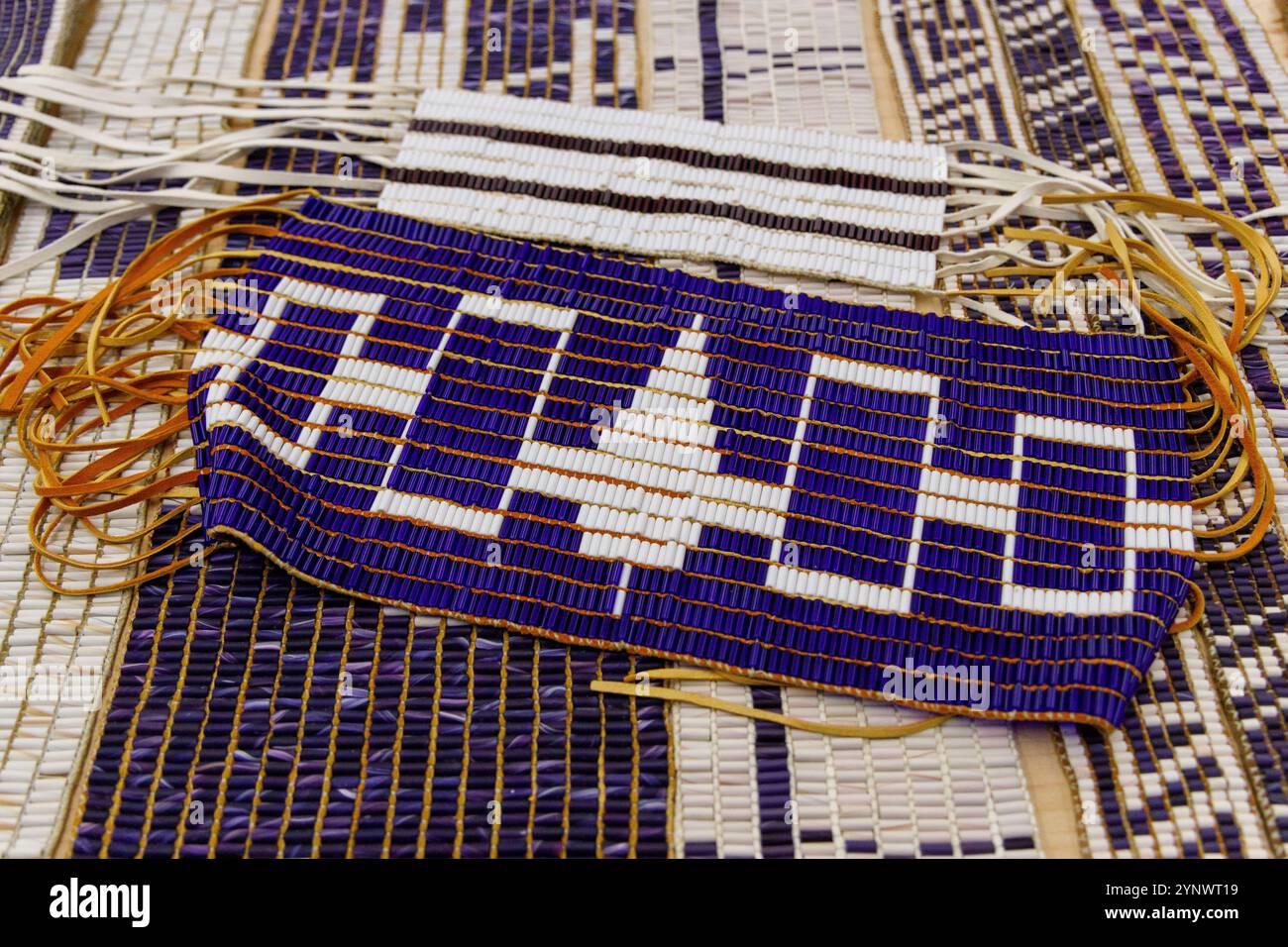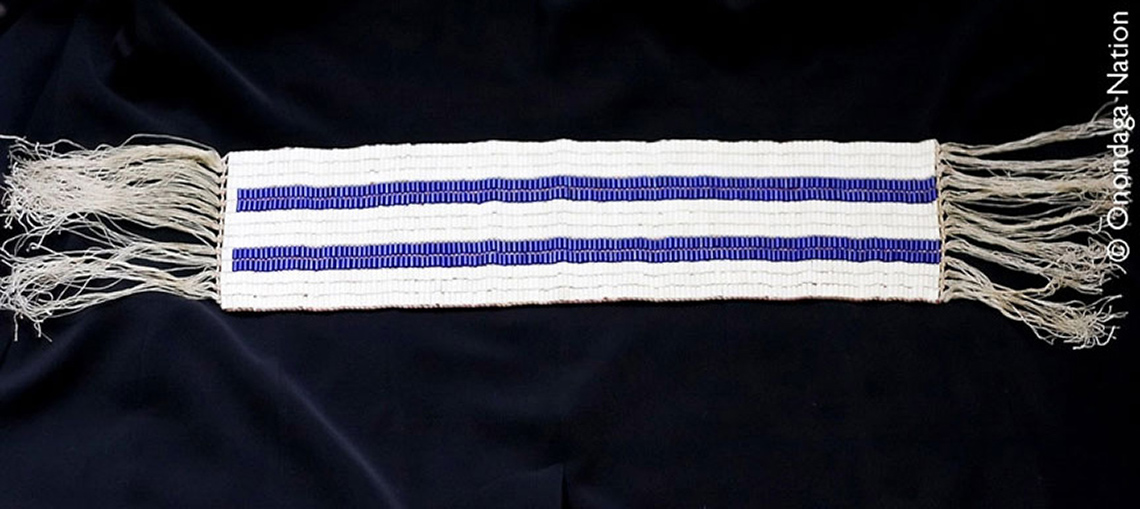
The Enduring Covenant: Two Row Wampum and the Imperative of Parallel Paths
More than four centuries ago, a simple belt woven with beads laid the foundation for one of the most profound and enduring principles of diplomatic relations in North America. Known as the Two Row Wampum Treaty Belt, or Kaswentha in the Mohawk language, this artifact, born from a 1613 agreement between the Haudenosaunee Confederacy (comprising the Mohawk, Oneida, Onondaga, Cayuga, Seneca, and later Tuscarora Nations) and the Dutch, transcends its historical origins. It stands today not merely as a relic of the past, but as a vibrant, living philosophy offering a powerful framework for nation-to-nation respect, non-interference, and peaceful coexistence in an increasingly complex world.
The story of the Two Row Wampum begins along the banks of what is now the Hudson River. As European colonizers, primarily the Dutch, began to establish a presence, the Haudenosaunee recognized the need for a clear understanding of how these distinct peoples would interact. The Haudenosaunee, already possessing a sophisticated system of governance through the Great Law of Peace, approached these newcomers with an offer of a relationship built on mutual respect. The resulting agreement was not written on parchment, but meticulously woven into a wampum belt, a traditional form of record-keeping and diplomacy for Indigenous peoples, utilizing shells as beads.
Decoding Kaswentha: A Symbol of Sovereignty and Coexistence
The visual language of the Two Row Wampum is both elegant and deeply symbolic. It consists of two parallel rows of purple wampum beads, separated by three rows of white wampum beads. Each element carries profound meaning:
- The Two Purple Rows: These represent two distinct vessels travelling down the river of life, side-by-side. One row symbolizes the Haudenosaunee people, their canoe carrying their laws, customs, traditions, and way of life. The other row represents the European people, their ship carrying their own laws, customs, religions, and technologies. The critical message is that these two vessels are meant to travel together, never merging, never attempting to steer the other.
- The Three White Rows: These beads symbolize the unbreakable bond of peace, friendship, and respect that must exist between the two nations. These principles are the glue, the shared river, that keeps the two vessels on their parallel journey, preventing them from colliding or attempting to dominate one another.

This visual metaphor encapsulates the essence of Kaswentha: a commitment to non-interference and mutual respect for sovereignty. It dictates that neither party shall impose its laws, religion, or customs on the other. It is a declaration of separate but equal nationhood, a recognition that distinct paths can coexist harmoniously. As Oren Lyons, Faithkeeper of the Onondaga Nation, famously stated, "The Two Row Wampum is the longest-standing treaty relationship in North America." Its longevity speaks to the enduring power and wisdom embedded in its principles.
A Living Treaty, Not a Dead Letter
Unlike many Western treaties, which are often viewed as static documents fixed in time, the Two Row Wampum is understood by the Haudenosaunee as a living treaty – a set of guiding principles that must be continually renewed and upheld through generations. It is a covenant, a sacred agreement that demands ongoing commitment and action. This distinction is crucial, as it elevates the Two Row from a mere historical artifact to a dynamic framework for contemporary nation-to-nation relations.
The spirit of Kaswentha requires both parties to periodically "polish the chain" of friendship, acknowledging that relationships require maintenance, dialogue, and a reaffirmation of foundational values. It is a perpetual invitation to engage in respectful conversation, to address grievances, and to ensure that the river of life remains clear and unpolluted for both vessels.
Historical Betrayal and the Erosion of Principles
While the Haudenosaunee steadfastly honored their commitment to the Two Row Wampum, the history of European and later Canadian and American relations with Indigenous peoples is largely a chronicle of its profound betrayal. The colonial mindset, often driven by doctrines of discovery, Manifest Destiny, and racial superiority, proved antithetical to the spirit of Kaswentha. Instead of parallel paths, there was a relentless push for assimilation, land expropriation, and cultural destruction.

Treaties were broken, lands were seized, and Indigenous governance systems were systematically undermined. Residential schools, the Indian Act in Canada, and similar policies in the United States were all direct violations of the Two Row’s principles of non-interference and respect for distinct ways of life. The European vessel, rather than traveling alongside, attempted to steer, capsize, or even sink the Indigenous canoe, leading to centuries of injustice, trauma, and dispossession.
The Haudenosaunee, however, never forgot the Two Row. They continued to carry its teachings, passing them down through oral tradition and ceremonial practices, even in the face of immense pressure and suffering. This steadfast commitment ensured that the principles of Kaswentha remained alive, ready to be reasserted when the opportunity arose.
Contemporary Relevance: A Blueprint for Reconciliation and a Sustainable Future
In the 21st century, as societies grapple with the legacies of colonialism, environmental crises, and persistent inequalities, the Two Row Wampum has re-emerged as an indispensable guide. It offers a powerful blueprint for reconciliation, not as an act of forgetting or simply apologizing, but as a profound re-commitment to the original principles of respectful coexistence.
- Nation-to-Nation Relationships: For governments in Canada and the United States, the Two Row provides a robust framework for building genuine nation-to-nation relationships with Indigenous peoples. It calls for moving beyond paternalistic policies to truly recognize and uphold Indigenous sovereignty, self-determination, and jurisdiction. It challenges the dominant paradigm of assimilation and instead champions a vision of distinct but equally valued nations working together.
- Environmental Stewardship: The metaphor of the shared river of life takes on heightened significance in the face of climate change and ecological degradation. The Two Row implies a shared responsibility for the health of the environment, a recognition that the well-being of both vessels depends on the vitality of the water they travel upon. Indigenous environmental ethics, deeply rooted in reciprocal relationships with the land, offer crucial insights for sustainable practices, echoing the Two Row’s call for collective stewardship.
- Intercultural Dialogue: Beyond political treaties, Kaswentha provides a model for all forms of intercultural engagement. It teaches that true respect involves listening, understanding, and acknowledging the validity of different worldviews, even when they diverge. It encourages dialogue without judgment, fostering empathy and mutual learning.
- Legal and Political Advocacy: Indigenous leaders and legal scholars frequently invoke the Two Row Wampum in land claims, resource disputes, and human rights advocacy. It serves as a powerful moral and historical precedent, reminding governments of their unfulfilled obligations and the enduring vision for equitable relations. It underscores that Indigenous rights are not "special rights," but inherent rights of self-governing nations, acknowledged long before the formation of modern states.
The Two Row Wampum Treaty Belt is more than just a historical artifact; it is a living philosophy, a profound statement of Indigenous diplomacy, and a timeless testament to the possibility of respectful coexistence. Its principles of peace, friendship, and respect, coupled with the imperative of non-interference and mutual sovereignty, offer a powerful alternative to the conflicts and divisions that plague the modern world.
As we navigate complex global challenges, the wisdom embedded in Kaswentha calls on all of us to examine our relationships with each other and with the natural world. It invites us to consider what it truly means to travel together down the river of life, each in our own vessel, respecting our distinct paths, and ensuring that the shared waters remain pure for generations to come. The message of the Two Row Wampum is not just for Indigenous peoples and governments; it is a universal call to embody the highest ideals of humanity: to live in parallel, in peace, and with unwavering respect.